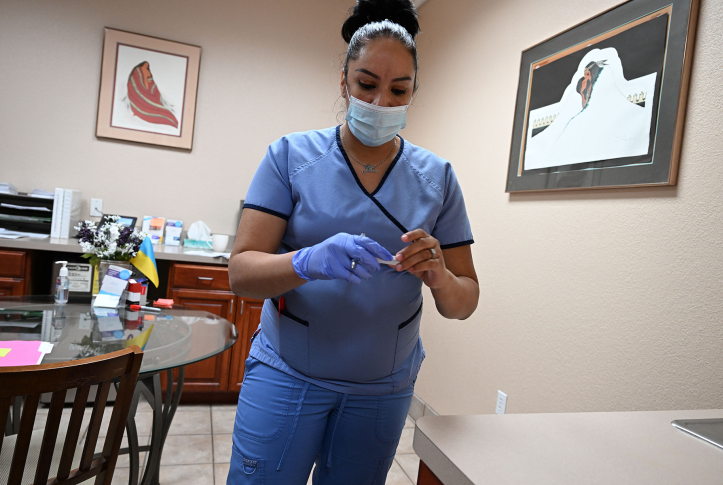The Supreme Court’s decision in Dobbs v. Jackson Women’s Health Organization overturning Roe v. Wade changes the health care landscape, especially in the 26 states that have already banned abortion or are likely to do so. Experts predict a grave and rapid impact on health, including a surge in unplanned pregnancies that may result in inadequate care, elevated rates of pregnancy complications, and increased rates of preterm births and infant and maternal mortality, among other problems. The impact will not be evenly distributed but will instead fall disproportionately on the poorest and people of color. These populations already experience the greatest health and health care inequities and depend heavily on public health and nutrition programs. Unfortunately, in these states, those services are underfunded.
As during other public health crises, safety-net providers — community health centers, public hospitals, family planning clinics, and clinics that specialize in care for people living with HIV/AIDS — will play a consequential role in this new environment. These providers have a mission to serve vulnerable populations and are typically located in underserved communities whose residents will feel the gravest impact from state abortion bans in terms of the health consequences of unplanned pregnancy.
Providers’ ability to shoulder these responsibilities depends on whether they receive the support they need to respond to maternal and infant care and preventive reproductive health needs. These funds come from two major sources: federal grant funds and Medicaid. In both cases, whether the necessary funding will be there will depend on the extent to which policymakers recognize the dramatically transformed environment in which these programs must function and respond accordingly.
Additional Federal Funding
Safety-net providers depend on federal grants. The 2023 federal appropriation bills were drafted prior to Dobbs, but Title V, Title X family planning, community health centers, and the National Health Service Corps will need to expand, as will community mental health programs. Ryan White clinics serving people living with HIV/AIDS also must increase their support for pregnant patients.
Medicaid
Safety-net providers play a major role in caring for Medicaid patients, their patients’ primary source of health insurance. For maternal and infant health, Medicaid is critical — it covers 43 percent of all births. Thus, state Medicaid policies will play a critical role for maternal and infant care generally and for the ability of safety-net providers to properly manage patient care needs. These include:
- Assuring Medicaid postpartum coverage. As of July, 20 states have implemented the new 12-month postpartum option, but many states with current or likely abortion bans have not done so. Furthermore, not all states expanding postpartum coverage have elected to offer the full 12 months of coverage. Twelve months is especially important for new mothers in states that have not expanded Medicaid as it will help them maintain uninterrupted coverage for themselves throughout the first year of their babies’ lives.
- Expanding pregnancy-related Medicaid eligibility. Some states with abortion bans or those likely to enact them also limit pregnancy-related Medicaid eligibility. For example, Alabama caps Medicaid pregnancy-based eligibility at 146 percent of the federal poverty level ($40,515 for a family of four in 2022), well below the national standard of 205 percent of poverty ($56,888 for a family of four). South Dakota caps eligibility at 138 percent of poverty ($38,295 for a family of four), the minimum pregnancy eligibility standard under federal law. Expanding coverage also would ensure a full year of continuous coverage for newborns, since babies born to mothers enrolled in Medicaid have automatic coverage for a year.
- Navigating the public health emergency wind-down. By causing a surge in births, abortion bans will increase the importance of Medicaid pregnancy and infant coverage. Yet the bans may coincide with Medicaid coverage interruptions, as the COVID public health emergency winds down and the special rule guaranteeing continuous eligibility ends. For now, the emergency period has been extended but when the wind-down happens, safety-net providers will provide critical enrollment support to help mothers and infants.
- Providing Early Periodic Screening and Diagnostic Treatment (EPSDT). Safety-net providers play a vital role in furnishing care to Medicaid-enrolled infants, children, and adolescents through Medicaid’s EPSDT benefit, which provides comprehensive coverage for children. Safety-net providers will need support to be able to furnish additional clinical and care management services, including home visits for high-risk cases. Because adolescent parents may be in particular need of support owing to high social risks, EPSDT also can provide additional resources for special community outreach.
- Enhanced family planning coverage. Medicaid is the single largest public funder of family planning services. The Biden administration can encourage states to adopt the family planning coverage option to help Medicaid reach additional populations. The administration can clarify that family planning coverage includes all FDA-approved methods (including emergency contraception), HPV immunization, HIV assessment, and immediate treatment of sexually transmitted infections (STIs), which threaten the health and lives of pregnant women and infants. Current rules classify STI services only as “family-planning-related” and therefore not qualified for the higher federal funding support to states that are part of Medicaid’s family planning guarantee as a means of encouraging comprehensive services.
Emergency Medical Treatment and Labor Act (EMTALA)
Safety-net hospitals will play an outsized role caring for people who experience pregnancy-related emergencies. The administration has taken action to clarify hospitals’ obligations in the case of pregnancy-related medical emergencies. These guidelines — now being legally challenged by Texas — offer an especially crucial federal safeguard in states with abortion bans. It is not only patients who depend on EMTALA. Hospitals and clinicians on the front lines rely on it to ensure they can act consistent with their obligations as medical professionals and without state interference.
Dobbs presents innumerable health care challenges. Strengthening and supporting safety-net providers — those on the front lines in the hardest-hit communities —will be vital. This means direct investments in safety-net capacity, as well as Medicaid policies that expand and enrich maternal and infant health care and stabilize enrollment. Finally, it means protecting EMTALA rights so that frontline hospitals can fulfill their mission.







